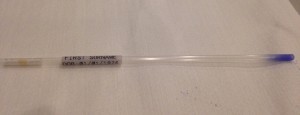Semen freezing is a routine procedure that has been available throughout Australia and the world for many years and is used to preserve sperm cells. All semen freezing mediums will use a cryoprotectant agent (such as glycerol) to protect the cells and gentamicin as an antibiotic. For the slow freezing method, the cryoprotectant is added in equal volumes in a drop wise manner before gradually decreasing the temperature until it can be frozen and stored in liquid nitrogen at -196 degrees Celsius.
Semen freezing is useful and recommended for both fertility preservation and fertility treatment.
Who May Benefit From Semen Freezing?
Men who are faced with the following, may find sperm freezing suitable for them:
- Ejaculatory problems or dysfunction
- Absence during a fertility treatment (due to work commitments)
- Work commitments with high risk occupations (e.g. defence force)
- Prior to chemotherapy treatment, or prior to surgery involving the male reproductive tract and/or testicles (which may render a man infertile)
- Prior to a vasectomy, or an unsuccessful vasectomy reversal
How Is Sperm Collected?
Usually fresh sperm is collected by either masturbation or surgical methods (e.g. MESA – micro-epidydimal sperm aspiration or TESE – testicular sperm extraction). If collection is via masturbation, the male should abstain from sexual activity for between 2-5 days and produce the sample into a sterile container. Ideally the sample would be produced at our clinic so that it can start to be processed immediately after collection.
A surgically retrieved sperm sample will be collected with either a fertility specialist under a local anesthetic, or with an urologist under a general anesthetic. If a general anesthetic is necessary, additional hospital fees will be required to be paid prior to the day of surgery.
What Happens Prior To Freezing?
Prior to freezing, the sample undergoes a complete semen analysis. This is to examine a number of important parameters including semen volume, sperm concentration, sperm motility and sperm morphology. The results of this testing will allow us to make a recommendation for future use of the frozen sample and these will be sent to your referring doctor within 3 working days.
Sperm Concentration: is a measurement of the density or number of sperm in the sample. It is usually reported as a value per millilitre and the normal value is greater than 15 million/mL. A reduced number of sperm present in a sample is referred to as oligospermia. In the event that no sperm are present in the sample, it is referred to as azoospermia.
Sperm Motility: refers to the movement of the sperm, especially forward progression, and is reported as a percentage. The movement of sperm is divided into three (3) categories:
- Progressive motility (PR), which refers to sperm moving actively, either linearly or in a large circle regardless of speed
- Non-progressive motility (NP), which refers to sperm which are not moving in a forward motion (i.e. absence of progression)
- Immotile, which refers to sperm that show no movement. Sperm which do not show movement may in fact be dead and therefore not capable of fertilising an oocyte.
If a sample shows reduced numbers of motile sperm it is referred to as asthenozoospermia.
Sperm Morphology: is a visual assessment of the shape of the sperm. This is reported as a percentage and the normal value is greater than 4%. A reduced number of normal appearing sperm is referred to as teratozoospermia.
Sperm concentration and motility is expected to be affected during the freezing process. This is because a cryoprotectant needs to be added to the semen at a ratio of 1:1 and unfortunately not all the sperm will survive the freezing and thawing process. Therefore if we consider a sample which initially is 50 million/mL prior to freezing, once the cryoprotectant is added this will reduce the sample concentration to approximately 25 million/mL.
Similarly, not all motile sperm will survive the process; in fact it is common that only somewhere between 25%-50% of motile sperm survive freezing and thawing. Therefore this too can impact what type of treatment the frozen sperm will be recommended for. It is suggested that if you have frozen sperm, to follow up with your specialist prior to proceeding with a cycle, to ensure that the sample is suitable for your planned treatment.

What Can Go Wrong?
The process of semen freezing is continually being revised and updated. Sometimes things can go wrong. Some of these things are outlined below:
- No sperm are present in the sample provided and as such no sperm is available for subsequent treatment.
- None of the sperm frozen survive the thawing process; this is very uncommon and more likely if the sperm quality was poor at time of production.
- The sample does not prepare as well as initially thought and as such may mean that either additional straws need to be thawed for treatment or another type of treatment is recommended in a subsequent cycle.
- The storage tank/dewar where the semen is stored can malfunction and as such the sample(s) can be lost.
What Fees Are Associated?
There will be an initial fee associated with the semen analysis and freeze cost. There may be additional costs for subsequent samples that are frozen, however this will depend on your reason for freezing. There will also be accounts (issued 6 monthly) for storage fees. Please contact Fertility Solutions Administration for more information.
How Long Can Samples Be Stored?
Semen can be stored indefinitely once frozen, however there are guidelines which recommend that samples are stored for a maximum of ten years.
Creating a Will
When you sign a consent for your gametes (sperm) to be frozen, it is very important that you have a will made or amend your will to indicate your intentions for use, or disposal, in the event of your death. Particularly, you should indicate your agreement (or otherwise), that your partner (if applicable) have future access to these gametes in your absence.
Using your Sperm In the Future
The chance of achieving a pregnancy with your frozen sample depends on the quality of the sample and the fertility of your partner (the largest predictor of this is the female age). Fertility rates with frozen samples are lower than with fresh semen, so we require that your partner be assessed by a fertility specialist.
The fertility specialist will then recommend one of the following options:
- Placing the sample in the woman’s uterus (womb) during the fertile time in her natural cycle (known as intra-uterine insemination/IUI)
- Using fertility stimulating medicines to increase the chance of success with intrauterine insemination
- IVF (in-vitro fertilization) where the semen sample is mixed with eggs obtained from the woman with a surgical procedure
- ICSI (intracytoplasmic sperm injection) where individual sperm are injected directly into eggs obtained from the woman with a surgical procedure
If you would like to book an appointment to discuss semen freezing, please contact us. You may also be interested in learning more about our Semen Analysis Test or donating sperm.
Arranging a Freeze
If you decide that you would like to freeze sperm, you will need to contact your GP/specialist to arrange for a referral to Fertility Solutions for a semen analysis and semen freeze. You will also need to complete any applicable screening tests. Once completed, you will need to phone Fertility Solutions to arrange an appointment. At this appointment you will be given the opportunity to discuss any further questions.


